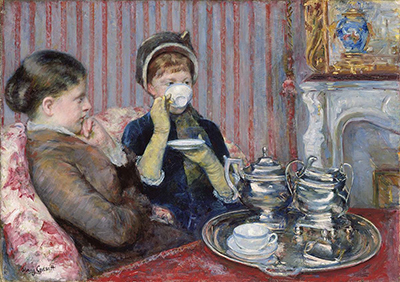Born in exciting times for young free-thinking American women, Mary Cassatt benefitted from her own mother's high-level of education which saw her supporting a life of learning and travel for her young daughter. Cassatt travelled for five years, and fell under the tutelage of the French Impressionists, notably Degas and Pissarro both of whom she met at the tender age of eleven or twelve, before she was old enough to travel by herself.
Once she was established in Paris, she quickly fell in with the Impressionists, learning from them and earning the respect of the establishment. Indeed, she gained the title of one of 'les trois grandes dames d'Impressionisme' (the three great ladies of Impressionism) from the noted critic Gustave Geffroy, for her neat capturing of moments of life. This painting is one such moment – one that, arguably a male artist would not have thought needed capturing for posterity. The Tea depicts a pair of young gentlewomen acting out a daily ritual that would have taken place day after day in genteel households all over the continent, Europe and America, social visits to take tea or coffee: to see and be seen. The two women depicted are seated on a settee, neither too close nor too far apart, while the impeccable tea-set, a silver service kept polished to a high shine, is ensconced upon a tray on the table in front of them, within easy reach of a refill for whichever one is 'playing Mother'.
However, in this painting Cassatt has offered an opinion on the life of such young gentlewomen, as yet unmarried but easily old enough to be paraded around in front of all the suitable young men in the hope that a meeting of like minds (or statuses) might take place. The figure in the centre of the picture has her cup to her face – indeed, covering much of her face, with only her eyes and the suggestion of faintly frowning brows to be seen. And yet the hand holding the cup is dainty and her little finger is extended in quite the right manner. Whatever the young woman really feels, we are being told, she is dutifully hiding it as per the demands of social convention.
The other figure tells us a little more. Seemingly unaware of the viewer's gaze, she appears bored. Not taking tea, nor making conversation, she has let the façade slip for a moment and is simply gazing into space. Her neatly smoothed hair, the slightly larger than life tea service and the manner in which the other young lady's face is concealed behind her tea-cup offers a glimpse of the fiery impatience of the social dictates of the day: impatience that would soon break out as the suffragette movement gained ground and began to exert its influence at the very highest levels of government. This subtly feminist painting in oil on canvas can be seen in the Suzanne and Terrence Murray Gallery in the Boston Museum of Fine Arts.




